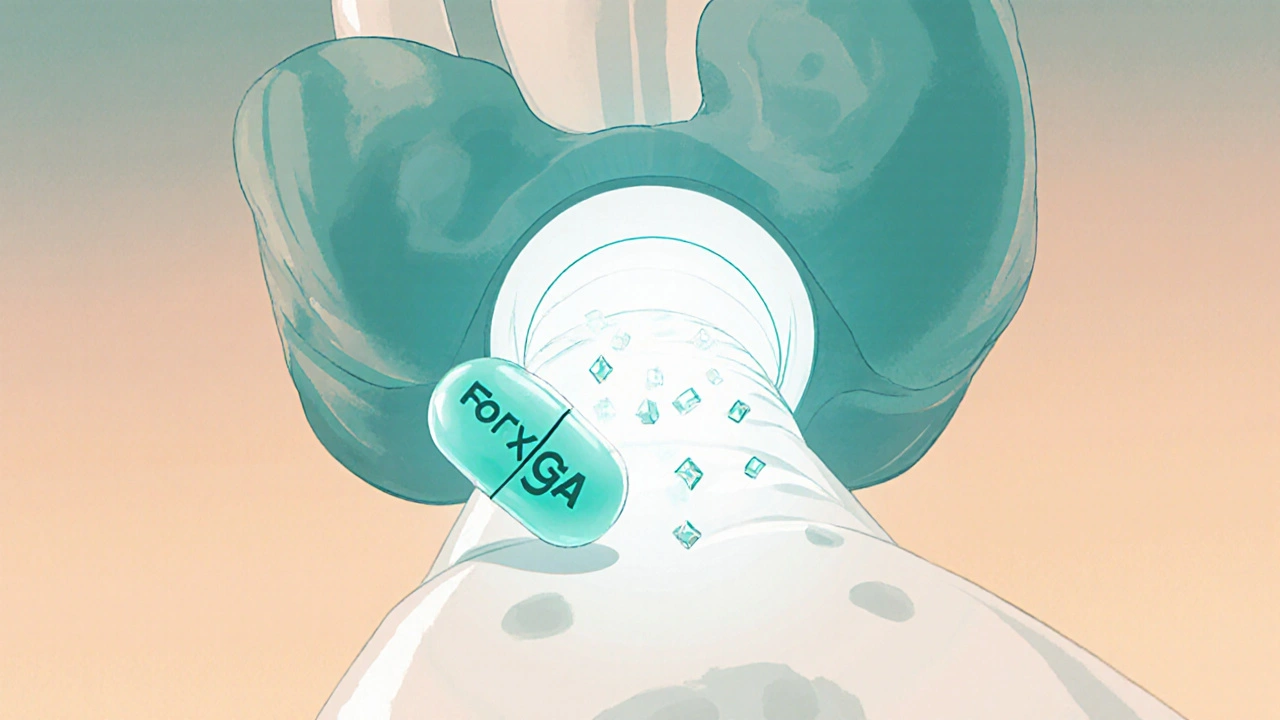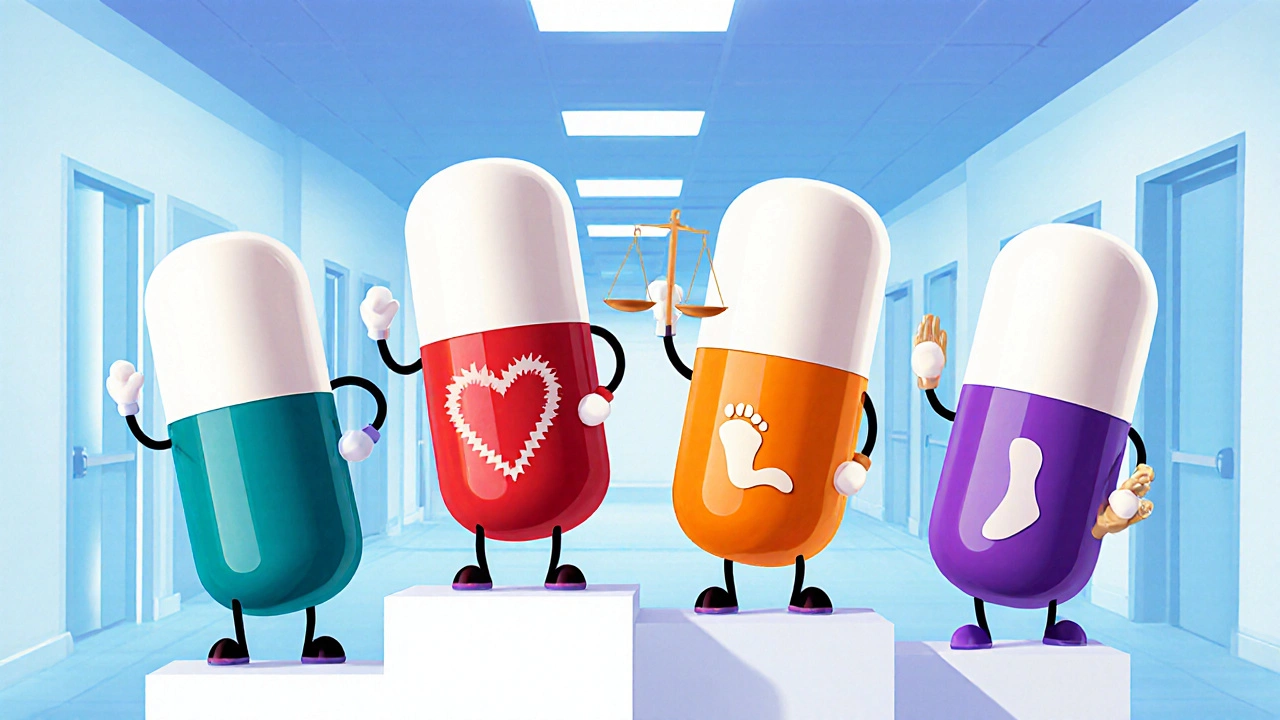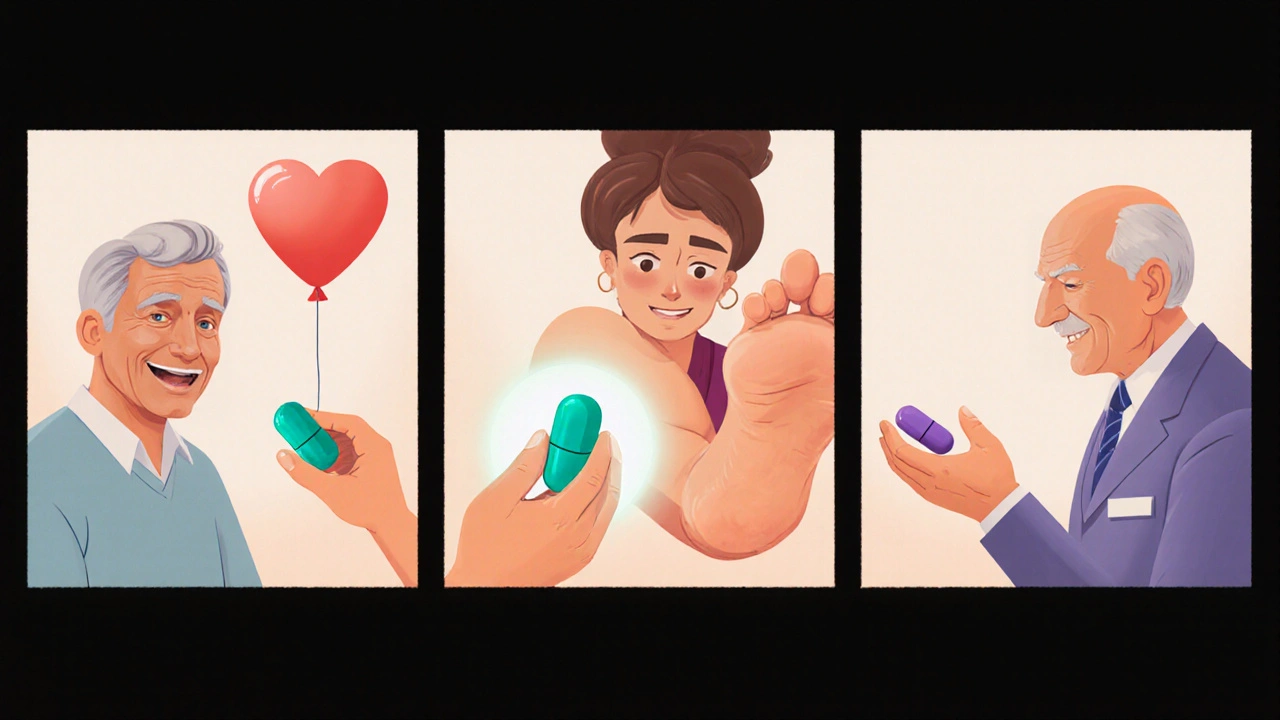Forxiga (dapagliflozin) vs Other SGLT2 Inhibitors: In‑Depth Comparison
 Oct, 16 2025
Oct, 16 2025
SGLT2 Inhibitor Selector
Personalized SGLT2 Inhibitor Selection
Select your patient's key characteristics to determine which SGLT2 inhibitor may be most appropriate for their individual needs.
Recommended SGLT2 Inhibitor
When it comes to managing type 2 diabetes, Forxiga has quickly become a household name. But is it really the best choice, or do other drugs offer a better balance of efficacy, safety, and cost? This guide breaks down Forxiga (dapagliflozin) side‑by‑side with its main rivals, highlighting who benefits most from each option.
What is Forxiga (dapagliflozin)?
Forxiga is a brand‑name medication whose generic name is dapagliflozin. It belongs to the SGLT2 inhibitor class, which lowers blood sugar by blocking the kidney’s sodium‑glucose co‑transporter‑2, causing excess glucose to be expelled in urine. Approved by the FDA in 2014, Forxiga is prescribed for adults with type 2 diabetes, and more recently for heart failure and chronic kidney disease.
Why Compare SGLT2 Inhibitors?
All SGLT2 inhibitors share a common mechanism, but they differ in dosing frequency, cardiovascular outcomes, renal protection, side‑effect profiles, and price. Understanding these nuances helps clinicians and patients pick the drug that aligns with individual health goals.
Key Players on the Market
- Jardiance (empagliflozin) - Strong evidence for reducing cardiovascular death.
- Invokana (canagliflozin) - First SGLT2 inhibitor approved, noted for renal benefits but higher amputation risk.
- Steglatro (ertugliflozin) - Once‑daily dosing, modest weight loss, and good tolerability.
Head‑to‑Head Comparison Table
| Attribute | Forxiga (dapagliflozin) | Jardiance (empagliflozin) | Invokana (canagliflozin) | Steglatro (ertugliflozin) |
|---|---|---|---|---|
| Typical Dose | 5‑10mg once daily | 10‑25mg once daily | 100‑300mg once daily | 5‑15mg once daily |
| HbA1c Reduction (average) | 0.5‑0.8%* | 0.6‑0.9%* | 0.6‑0.8%* | 0.5‑0.7%* |
| Weight Loss (kg) | ≈2‑3kg | ≈1‑2kg | ≈2‑4kg | ≈2kg |
| Cardiovascular Outcome Benefit | Reduced CV death (HR0.82) | Reduced CV death (HR0.62) | No significant CV death benefit | Neutral CV impact |
| Renal Protection | Slows eGFR decline | Strong renal benefit | Improves albuminuria | Modest renal benefit |
| Common Side Effects | Genital mycotic infection, UTIs | Same as Forxiga | Same + higher amputation risk | Same, lower genital infection rates |
| FDA‑Approved Indications (2024) | Type2DM, HFrEF, CKD | Type2DM, HFrEF, CKD | Type2DM, CKD | Type2DM |
| Average Monthly Cost (UK, 2025) | £78 | £84 | £92 | £80 |
*Based on pooled data from phaseIII trials.

How to Choose the Right SGLT2 Inhibitor
- Cardiovascular risk: If you have established heart disease, Jardiance’s proven mortality reduction often tips the scales.
- Kidney function: For moderate CKD, Forxiga and Jardiance both slow eGFR decline, but Forxiga has the simplest dosing.
- Amputation concern: Patients with peripheral artery disease should avoid Invokana unless benefits outweigh risks.
- Cost & insurance: In the UK, the NHS formulary generally prefers the cheapest option with comparable efficacy-often Forxiga or Steglatro.
- Combination therapy: All agents pair well with metformin; Forxiga is also safe with GLP‑1 receptor agonists for added weight loss.
Real‑World Patient Scenarios
Case 1 - Middle‑aged man with heart failure: John, 58, has NYHA classII heart failure and a HbA1c of 8.2%. His cardiologist chooses Jardiance because the EMPA‑REG OUTCOME trial showed a 38% reduction in cardiovascular death. After six months, his NT‑proBNP falls and his HbA1c drops to 7.3%.
Case 2 - Woman with early chronic kidney disease: Maria, 62, has an eGFR of 55mL/min/1.73m² and is already on metformin. The nephrologist picks Forxiga for its renal‑protective label and cheaper price. Six months later, her eGFR declines only 1mL/min, and her HbA1c improves to 7.0%.
Case 3 - Patient at high amputation risk: Sam, 70, has peripheral artery disease. The physician steers clear of Invokana, opting for Steglatro, which has a lower reported amputation rate while still delivering decent glucose control.
Safety Tips & Common Pitfalls
- Hydration is key - SGLT2 inhibitors increase urinary glucose loss, raising the risk of dehydration.
- Watch for genital infections; early treatment prevents complications.
- Avoid in patients with eGFR < 30mL/min unless specifically approved for CKD.
- Do not combine with a keto‑diet without medical supervision - risk of euglycemic ketoacidosis.

Regulatory Landscape (2024‑2025)
The FDA and EMA have expanded SGLT2 indications beyond glucose control. In 2023, the FDA approved Forxiga for heart failure with reduced ejection fraction, and in 2024 for diabetic kidney disease. Europe followed with similar labeling for Jardiance. These updates mean clinicians now choose agents based on organ‑specific benefits, not just glucose lowering.
Bottom Line: Which Drug Wins?
There’s no one‑size‑fits‑all answer. If cardiovascular mortality reduction is the top priority, Jardiance leads the pack. For patients needing a cost‑effective, kidney‑friendly option, Forxiga stands out. When amputation risk looms, steer clear of Invokana. And for a simple once‑daily pill with solid overall performance, Steglatro is a worthy contender.
Frequently Asked Questions
How does Forxiga work compared to other SGLT2 inhibitors?
All SGLT2 inhibitors block the sodium‑glucose cotransporter‑2 in the renal proximal tubule. Forxiga’s selectivity is high, leading to a slightly lower risk of off‑target effects. The net result is more glucose excreted in urine, lowering blood sugar and providing modest calorie loss.
What are the main side effects of Forxiga versus Invokana?
Both drugs share genital yeast infections and urinary tract infections. Invokana, however, carries a higher reported incidence of lower‑extremity amputations and bone fractures, especially at higher doses.
Can Forxiga be combined with insulin?
Yes. Forxiga is often added to basal‑insulin regimens to improve glycemic control without a major increase in hypoglycemia risk, because its glucose‑lowering effect is insulin‑independent.
Is Forxiga safe for people with moderate kidney disease?
Current guidelines allow Forxiga down to an eGFR of 30mL/min/1.73m² for diabetes control, and down to 25mL/min for heart‑failure or CKD indications, provided patients are monitored closely.
How do costs compare across the four drugs?
In the UK (2025), average monthly NHS prices are roughly £78 for Forxiga, £84 for Jardiance, £92 for Invokana, and £80 for Steglatro. Insurance coverage and local formularies can shift these numbers significantly.

Hariom Godhani
October 16, 2025 AT 16:00The saga of SGLT2 inhibitors reads like a modern tragedy where profit motives eclipse patient welfare. In the glossy brochures, Forxiga is painted as the benevolent savior for heart and kidney, yet the fine print reveals a cascade of hidden costs. Every new indication feels like a marketing ploy rather than a genuine therapeutic breakthrough, and clinicians are left juggling a maze of guidelines. The cardiovascular benefit of Jardiance, while impressive, is trumpeted with such fervor that the modest weight loss advantage of Steglatro is easily dismissed. Meanwhile, the amputation risk attached to Invokana is glossed over, buried deep in the safety section of the label. One cannot ignore the fact that the UK pricing table shows Forxiga as the cheapest, but the real financial burden lies in the co‑pay structures that vary wildly across insurers. Moreover, the renal protection data, though promising, are derived from heterogeneous populations, making it hard to extrapolate to real‑world patients. Physicians are forced to play a guessing game, balancing heart failure outcomes against the specter of genital infections. The underlying mechanism-glucose excretion-remains unchanged across the class, so the subtle differences are mostly pharmacokinetic nuances. Patients with peripheral artery disease deserve a clear warning about Invokana, yet the warning labels are often lost amidst the promotional material. The narrative that Forxiga’s dosing simplicity is a decisive factor ignores the fact that adherence is multifactorial and heavily influenced by side‑effect profiles. In practice, the decision often collapses into a cost‑effectiveness analysis that rarely accounts for individual patient preferences. The regulatory expansions in 2024‑2025 have only added layers of complexity, turning a once‑straightforward drug class into a labyrinth of indications. Ultimately, the clinician’s oath to do no harm clashes with a pharmaceutical landscape that rewards novelty over nuance. The only rational path forward is a patient‑centric discussion that cuts through the hype and focuses on tangible outcomes.
Breanna Mitchell
October 18, 2025 AT 23:33Great breakdown! I love how you highlighted the cost differences-so many folks don’t realize Forxiga can actually be the wallet‑friendly option while still delivering solid heart and kidney benefits.
Alice Witland
October 21, 2025 AT 01:33Oh, look at us, comparing pills like we’re picking a new smartphone. Because who doesn’t love a good side‑effect table to spice up their afternoon?
Chris Wiseman
October 22, 2025 AT 22:00When we stare into the abyss of glucose control, the abyss stares back and whispers that the real battle isn’t between Forxiga and Jardiance, but between our reverence for data and our lust for novelty. One could argue that the marginal HbA1c reductions are merely statistical fireworks, dazzling yet fleeting. The weight‑loss figures, though touted, often vanish once patients abandon the regimen. Meanwhile, the cardiovascular mortality stats are a siren song that lures clinicians into prescribing based on headline numbers rather than patient narratives. If we peel back the layers, we find that adherence hinges on lifestyle synergy, not just pill color. The renal protective mechanisms, while biologically plausible, remain insufficiently powered in many trials. Currency fluctuations and formularies further muddle the cost‑effectiveness equation, turning a simple decision into a fiscal odyssey. So, while the table is tidy, the lived experience of diabetes management is a chaotic tapestry that no single drug can fully capture.
alan garcia petra
October 24, 2025 AT 12:53For most patients, the simplicity of once‑daily dosing wins.
Allan Jovero
October 25, 2025 AT 22:13It is imperative to note that the presented data adhere to standard statistical conventions; however, the omission of confidence intervals for cardiovascular outcomes constitutes a methodological oversight.
Andy V
October 27, 2025 AT 01:00Honestly, the article skips over the fact that the amputation risk with Invokana isn’t a myth-it’s a real, documented concern that many downplay.
Tammie Sinnott
October 28, 2025 AT 02:00Let’s unpack the numbers: Forxiga’s average monthly cost sits at £78, which is modest compared to Invokana’s £92. That £14 difference can be the deciding factor for patients on a tight budget, especially when you consider that the efficacy gap in HbA1c reduction is only about 0.1‑0.2%. Moreover, the renal protection offered by Forxiga is comparable to Jardiance, but without the premium price tag. In practice, I’ve seen patients switch from the pricier options to Forxiga and maintain stable eGFR trajectories, all while reducing out‑of‑pocket expenses. The weight‑loss advantage, though modest, still contributes to overall metabolic health. It’s also worth mentioning that the genital infection rates, while present, can be mitigated with proper hygiene education. Bottom line: For many, Forxiga hits the sweet spot between cost, efficacy, and safety.
Michelle Wigdorovitz
October 29, 2025 AT 00:13From a cultural standpoint, it’s fascinating how the UK NHS formulary tends to favor the cheaper option, essentially nudging clinicians toward Forxiga. In the US, insurance formularies can swing the decision in the other direction, often pushing Jardiance because of negotiated rebates. This geopolitical tug‑of‑war underscores the importance of understanding local healthcare economics before making a blanket recommendation. It also reminds us that the “best” drug isn’t universal-it’s context‑dependent.
Arianne Gatchalian
October 29, 2025 AT 19:40I totally get the struggle of choosing the right SGLT2 inhibitor. It helps to sit with your healthcare team, discuss personal priorities-whether it’s heart health, kidney protection, or just budget-and then make a shared decision. You’re not alone in feeling overwhelmed.
Aly Neumeister
October 30, 2025 AT 12:20Wow!This article is... thorough!; but... the tables? They could be clearer? nonetheless-good job.
joni darmawan
October 31, 2025 AT 02:13Considering the philosophical underpinnings of medical choice, one might argue that prescribing a medication reflects a deeper commitment to patient autonomy. Yet, the constraints of formularies and evidence‑based guidelines often limit that freedom, positioning the clinician in a deterministic framework where the optimal drug is pre‑selected by external forces.
Richard Gerhart
October 31, 2025 AT 13:20Hey folks, just a heads up-if you're on Forxiga and notice any weird urinary infections, hit up ur doc ASAP. Also, staying hydrated can really cut down on those side effects. Hope this helps!
Kim M
October 31, 2025 AT 21:40Sure, the big pharma “research” is just a front for gathering our data 🤔💊